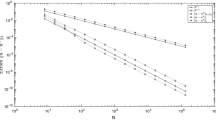Abstract
The aim of this paper is to investigate whether we can accelerate the order of convergence of existing high order methods to solve some singularly perturbed two-point BVPs. To this end, we consider a fitted mesh finite difference method of Patidar (Appl. Math. Comput., 188:720–733, 2007) applied on a mesh of Shishkin type for the solution of self-adjoint problem which is ε-uniformly convergent of order four. We attempted to increase the order of convergence by Richardson’s extrapolation and discovered that this well-known convergence acceleration technique has some limitations. We observe that even though this extrapolation technique improves the accuracy slightly, it does not increase the rate of convergence which is originally four for the underlying method for the problem above. Theoretical investigations are demonstrated by some numerical experiments.
Similar content being viewed by others
References
Andreev, V.F., Popov, A.M.: Using Richardson’s method to construct high-order accurate adaptive grids. Comput. Math. Model. 10(3), 227–238 (1999)
Doolan, E.P., Miller, J.J.H., Schilders, W.H.A.: Uniform Numerical Methods for Problems with Initial and Boundary Layers. Boole Press, Dublin (1980)
Gartland, E.C.: Uniform high-order difference schemes for a singularly perturbed two-point boundary value problem. Math. Comput. 178(48), 551–564 (1987)
Gaunt, J.A.: The deferred approach limit II: Interpenetrating lattices. Philos. Trans. R. Soc. Lond., Ser. A, Math. Phys. Eng. Sci. 226, 350–361 (1927)
Grekov, L.D., Krasnikov, V.M.: FD method of arbitrary uniform order accuracy for solving singularly perturbed boundary problems for second-order ordinary differential equations. J. Math. Sci. 77(5), 3420–3425 (1995)
Herceg, D.: On the numerical solution of a singularly perturbed nonlocal problem. Zb. Rad. Prirod. Mat. Fak. Ser. Math. 20(2), 1–10 (1990)
Joyce, D.C.: Survey of extrapolation process in numerical analysis. SIAM Rev. 13(4), 435–490 (1971)
Keller, H.B.: Accurate difference methods for linear ordinary differential systems subject to linear constraints. SIAM J. Numer. Anal. 6, 8–30 (1969)
Linss, T.: Error expansion for a first-order upwind difference scheme applied to a model convection-diffusion problem. IMA J. Numer. Anal. 24, 239–253 (2004)
Miller, J.J.H., O’Riordan, E., Shishkin, G.I.: Fitted Numerical Methods for Singular Perturbation Problems. World Scientific, Singapore (1996)
Natividad, M.C., Stynes, M.: Richardson extrapolation for a convection-diffusion problem using a Shishkin mesh. Appl. Numer. Math. 45, 315–329 (2003)
O’Riordan, E., Stynes, M.: A uniform finite element method for a conservative singularly perturbed problem. J. Comput. Appl. Math. 18(2), 163–174 (1987)
Patidar, K.C.: High order fitted operator numerical method for self-adjoint singular perturbation problems. Appl. Math. Comput. 171(1), 547–566 (2005)
Patidar, K.C.: High order parameter uniform numerical method for singular perturbation problems. Appl. Math. Comput. 188, 720–733 (2007)
Richardson, L.F.: The deferred approach to the limit. I: Single lattice. Philos. Trans. R. Soc. Lond., Ser. A, Math. Phys. Eng. Sci. 226, 299–349 (1927)
Shishkin, G.I.: Robust novel high-order accurate numerical methods for singularly perturbed convection-diffusion problems. Math. Model. Anal. 10(4), 393–412 (2005)
Shishkin, G.I., Shishkina, L.P.: The Richardson extrapolation technique for quasilinear parabolic singularly perturbed convection-diffusion equations. J. Phys. 55, 203–213 (2006)
Stynes, M., O’Riordan, E.: A finite element method for a singularly perturbed boundary value problem. Numer. Math. 50, 1–15 (1986)
Vulanović, R.: Higher-order monotone schemes for a nonlinear singular perturbation problem. Z. Angew. Math. Mech. 68(5), T428–T430 (1988)
Vulanović, R.: A higher-order method for stationary shock problems. Appl. Math. Comput. 108, 139–152 (2000)
Vulanović, R.: A higher-order scheme for quasilinear boundary value problems with two small parameters. Computing 108, 139–152 (2000)
Wang, G.Y.: The application of integral equations to the numerical solution of nonlinear singular perturbation problems. J. Comput. Math. 12(1), 36–45 (1994)
Author information
Authors and Affiliations
Corresponding author
Additional information
The research contained in this paper was supported by the South African National Research Foundation.
Rights and permissions
About this article
Cite this article
Munyakazi, J.B., Patidar, K.C. Limitations of Richardson’s extrapolation for a high order fitted mesh method for self-adjoint singularly perturbed problems. J. Appl. Math. Comput. 32, 219–236 (2010). https://doi.org/10.1007/s12190-009-0245-6
Received:
Revised:
Published:
Issue Date:
DOI: https://doi.org/10.1007/s12190-009-0245-6
Keywords
- Singular perturbations
- Boundary value problems
- Fitted mesh finite difference methods
- Richardson’s extrapolation
- Shishkin mesh




